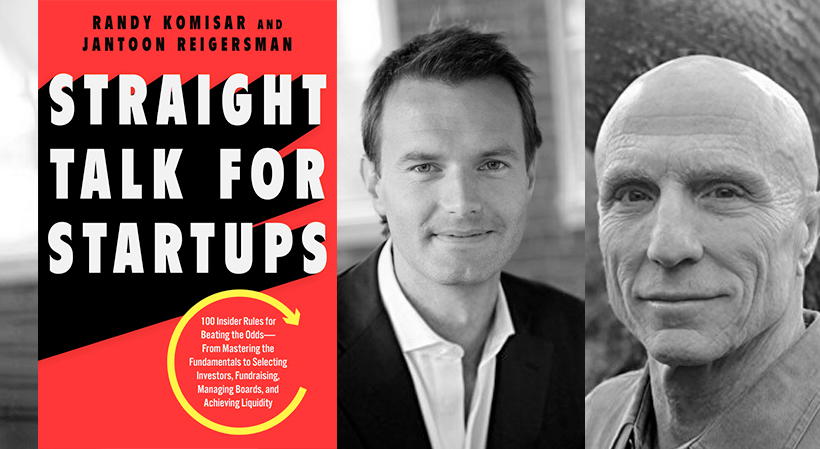The following is excerpted from “Straight Talk for Startups: 100 Insider Rules for Beating the Odds—From Mastering the Fundamentals to Selecting Investors, Fundraising, Managing Boards, and Achieving Liquidity” by Randy Komisar and Jantoon Reigersman. Copyright © 2018 by Randy Komisar and Jantoon Reigersman. Published on June 5, 2018 by Harper Business, an imprint of HarperCollins Publishers. Reprinted by permission.
Start small, but be ambitious
The most famous and impactful entrepreneurs all have bold ambitions. They envision their innovations driving global change and massive opportunities. But unless you are fortunate enough to have a Midas-level track record, you are most likely unable to assemble all the resources you will need to chase the entire dream at once. You will have to cut to fit and stage your success, systematically focusing your limited resources on proving out the “leaps of faith” (the core assumptions in your plan that must be correct for you to succeed) at each juncture, until you can demonstrate to your stakeholders that your business is firing on all cylinders and only requires more fuel to reach your destination.
If you were Reed Hastings in 1997, and you had a vision for transforming the home entertainment business by streaming videos created by your own studio to a global audience, would you have tried to sell that vision to investors in the face of a slow, low-quality Internet and dominant cable and broadcast content distribution players like Comcast and NBC? Or would you have sharpened your focus and attacked a large but vulnerable link in the chain—Blockbuster, the retail distributor of DVDs—with your own novel subscription service? And when Blockbuster offered to acquire your company and make you wealthy, would you have sold? Or would you have moved toward a strategy of distributing the existing library of movies over the Internet as the speed and the quality of service improved?
Fourteen years later, in 2011, when Hastings finally decided to train all his attention on the big idea and make a clean break with his DVD subscription business—naming it Qwikster to distinguish it from his sweeping vision of online entertainment at Netflix—customers weren’t ready, and he wisely backtracked. One step at a time. Ultimately, Netflix has been able to realize its vision with award-winning content that is heralded for starting a renaissance of quality home entertainment serving a massive, binge-watching global audience. It has taken many billions of dollars, money Hastings could not have hoped to raise for such an outlandish idea in 1997. But Netflix didn’t rush ahead of the developing technology, the evolving customer behaviors, or the changing competitive landscape. Instead, it successfully conquered physical distribution, online distribution, content creation, and global expansion as each opportunity became ripe for the taking. Patience, focus, and tenacity paid off. Not to mention an exquisite sense of timing and maybe a little luck.
Even entrepreneurs fortunate enough to command the resources necessary to chase the big idea directly need to pace themselves, testing fundamental assumptions and removing risk methodically. Rushing leads to missteps, which can lead to wasted time and opportunity. In fact, entrepreneurs should always conduct early, low-cost tests of their ideas to ensure that they are on the right track and the contribution factor is real.
Related: Activating on Ideas to Build Your Startup’s Products and Ventures
The best ideas originate with founders who are users
In general, the best innovations come from people who personally value and use them. Steve Jobs and Steve Wozniak wanted to bring the magic of IBM mainframes into their homes and created Apple Computer to pioneer personal computing. Travis Kalanick could not get a cab at a presidential inauguration event, so he created an on-demand car service and called it Uber. Google’s search engine was built by Larry Page and Sergey Brin at Stanford as they struggled to make sense of the exploding amount of information online. Facebook was initially created by Mark Zuckerberg for Harvard students like himself to “rate” their fellow classmates. Yvon Chouinard started Patagonia so he could produce ecologically sound products for himself and his merry band of climbers and surfers. Tony Fadell needed a reliable way to manage energy consumption at his mountain home and invented the Nest thermostat. Reed Hastings was furious about his late fees at Blockbuster and created Netflix. All of these entrepreneurs started with a deep understanding of the needs of the customer because they were target customers themselves. When the market responded to their innovations, they built powerful businesses from their ideas.
This is a basic difference between an inventor and an entrepreneur.
An inventor creates some amazing breakthrough that captures the imagination. An entrepreneur innovates a product or service that moves beyond imagination to address a real customer need that presents an attractive market opportunity. And don’t confuse an entrepreneur with a CEO. A CEO brings leadership, strategy, and operations to build a successful business from an attractive market opportunity. One person may well be effective at all three—inventor, entrepreneur, and CEO—but they are distinctly different roles and competencies.
Target fast-growing, dynamic markets
Many entrepreneurs target existing, large markets, because that is where the money is—or so it seems. But the typical mature market has five to seven relevant competitors, of which two generally capture more than 70 percent of the profits and therefore can out-invest the others. The competitive barriers to a new entrant are daunting. This is why an order-of-magnitude innovation is so important: you will need an unfair advantage to disrupt the status quo.
However, it is best to avoid biting off too much too soon. Instead, target smaller, specialized, higher-margin entry markets where you can establish a foothold. Focus on becoming the leader within a market segment poised for fast growth, and expand from there. This is what Tesla’s stated strategy boils down to: don’t start by going after the big car manufacturers with mass-market vehicles; rather, provide the well-heeled luxury market’s early adopters interested in paying for groundbreaking clean-energy electric vehicles with high-priced cars that barely cover manufacturing costs. Then, as your technology and know-how move down the cost curve and your brand becomes even more coveted, enter larger but more competitive higher-volume segments of the industry. Resist subsidizing mass-market customers with your expensive venture capital before you are certain it will help you quickly reach profitable volumes.
This is a variation on the innovator’s dilemma, wherein a market leader rejects introducing an innovation because its quality and/or price does not expand its existing large market. The incumbent’s product is at the waning edge of the technology S curve of price, quality, and features. New entrants seize the opening to sell a suboptimal product (high price, limited features, and/or technology constraints) to an early-adopter market and expand their market as their functionality increases and cost decreases, ultimately toppling the incumbent.
When Sony entered the audio market with its transistor radio to compete against tube-powered hi-fi systems, it sold on price and convenience, not quality. What we are suggesting is that you actually find niche markets with deep enough pockets to pay for you to develop the full power of your innovation while you are still on the expensive side of the S curve. Then expand your market later as costs fall and functionality continues to improve. The original Tesla Roadster cost $109,000 and had a range of 244 miles. Nine years later, the Tesla Model 3 costs $35,000 and has a range of 310 miles. Detroit, Munich, and Toyota City, beware. Whenever Tom Perkins was asked about how venture capitalists would evaluate an idea or business plan, he would always answer with a joke: “I cannot tell you how to write or create one; I can only tell you how we read one: we start at the back, and if the numbers are big, we look at the front to see what kind of business this is. It is not very sophisticated.”
Good advice: paint a big picture, but focus like a laser on the near-term business opportunity.
Sign Up: Receive the StartupNation newsletter!
“Straight Talk for Startups: 100 Insider Rules for Beating the Odds—From Mastering the Fundamentals to Selecting Investors, Fundraising, Managing Boards, and Achieving Liquidity” is available now at fine booksellers and can be purchased via StartupNation.com.






